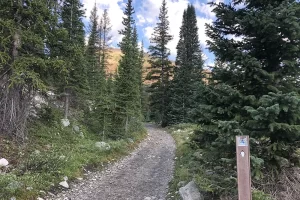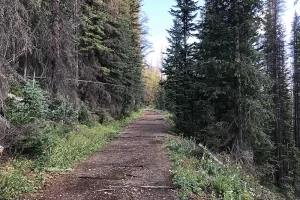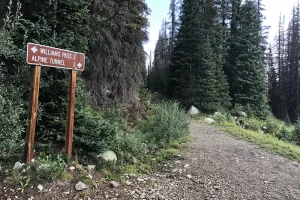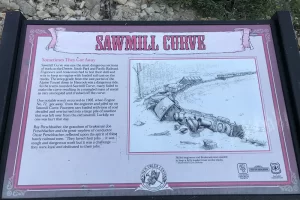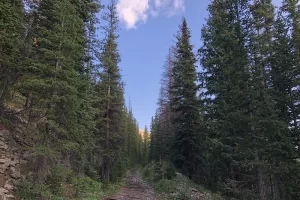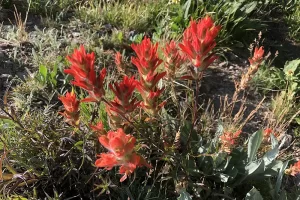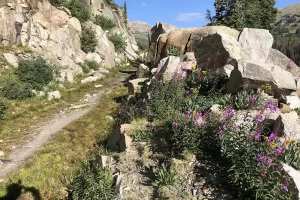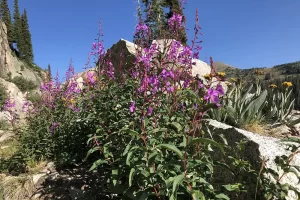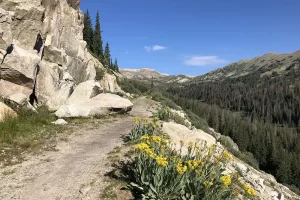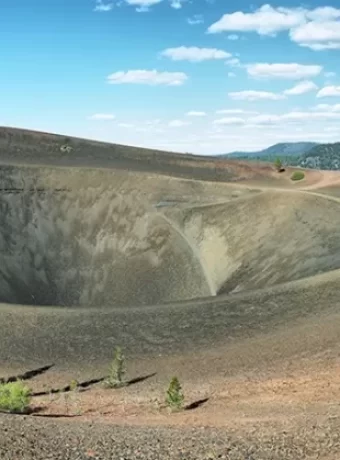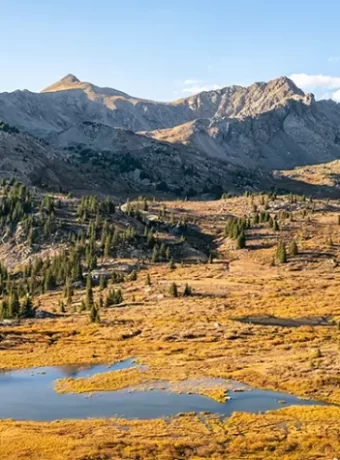Hike East Alpine Tunnel: Uncover Hancock’s Rich Colorado History
Ready for an adventure that’ll take you back in time? The East Alpine Tunnel trail isn’t just a hike – it’s a portal to Colorado’s rich mining past. As you trek through the stunning San Isabel National Forest, you’ll uncover the remnants of Hancock, a ghost town with a story to tell.
I’ve always been fascinated by the grit and determination of the miners who carved out a life in these rugged mountains. And let me tell you, the East Alpine Tunnel trail brings that history to life in a way that’ll leave you in awe.
So lace up your boots and join me on a journey through time. Trust me, this is one hike you won’t forget.
Table of Contents
Hiking the Historic Alpine Tunnel Trail
If you’re looking for a hike that’s equal parts breathtaking and historically fascinating, look no further than the Alpine Tunnel Trail in Colorado. This popular trail follows the old railroad grade of the Denver, South Park and Pacific Railroad, leading you on a journey through time to the once-bustling mining town of Hancock and the engineering marvel that is the Alpine Tunnel.
Trail Overview
The Alpine Tunnel Trail is a moderate to challenging hike, covering about 5.8 miles out and back. You’ll be rewarded with spectacular views of the surrounding mountains and valleys as you climb steadily from an elevation of around 11,000 feet at the trailhead to nearly 12,000 feet at the tunnel entrance. Along the way, you’ll encounter interpretive signs that offer insights into the history of the Alpine Tunnel and the people who built and used it. It’s a great opportunity to learn about Colorado’s rich mining heritage while enjoying a beautiful hike in the San Isabel National Forest.
This is a great family hike, very little elevation gain. Now camping in this bowl is for the hearty. I have experienced frost end of July first week of August.
Getting to the Trailhead
To reach the trailhead, you’ll need to navigate some dirt roads, but don’t let that deter you. From Buena Vista, head west on County Road 162 for about 12 miles until you reach the ghost town of St. Elmo. Just before entering the town, turn left onto County Road 295 and follow it for approximately 8 miles to the trailhead parking area. The road can be a bit rough in spots, so a high-clearance vehicle is recommended. Trust me, though – the drive is all part of the adventure, and the stunning scenery along the way will make it well worth the effort. Aspen groves in the fall are incredible.

Graphic Hoodies, Leggings, Outdoor Apparel
Hiking, backpacking, camping, and fly fishing apparel to fit any adventure. Graphic Hoodies Outdoor Apparel. Hiking Outdoor Apparel is a sun protective UPF-50, designed and field test by crew.
- East Alpine Tunnel Trail is part of the Continental Divide and Colorado Trails.
- East Alpine Tunnel Trail is an old Railroad Line hauling ore from Leadville, Colorado.
- Junction to the Palisades, a Colorado Trail Alternate. And a Beautiful Hike. One fourth of July. The snow was over 6' deep and I didn't have any snowshoes.
What to Expect on the Hike
As you set out on the Alpine Tunnel Trail, be prepared for a steady climb through alpine meadows and forests. The trail follows the old railroad grade, which means it’s relatively wide and well-maintained, but the elevation gain can still be challenging, especially if you’re not used to hiking at high altitudes. Take your time, stop to catch your breath and admire the views, and don’t forget to hydrate regularly. The air is thin up here, and it’s easy to get dehydrated without realizing it. About halfway through the hike, you’ll reach the site of the former town of Hancock. Take some time to explore the remnants of this once-thriving mining community, which we’ll dive into more detail about later. From Hancock, the trail continues to climb towards the Alpine Tunnel. You’ll pass through a series of switchbacks before reaching the tunnel entrance, which is now collapsed but still an impressive sight to behold.
Best Time to Hike
The best time to hike the Alpine Tunnel Trail is typically from July through September, when the high-country snow has melted and the wildflowers are in bloom. However, keep in mind that afternoon thunderstorms are common in the summer months, so it’s best to start your hike early in the day and be prepared for rapidly changing weather conditions. I remember one August hike where I set out under bluebird skies, only to find myself racing back down the trail a few hours later as dark clouds gathered and lightning crackled in the distance. The key is to stay aware of your surroundings and be ready to turn back if necessary. No matter when you go, the Alpine Tunnel Trail is sure to leave you in awe of both the natural beauty of the Colorado Rockies and the incredible feats of engineering and human perseverance that made this historic route possible.
Exploring the Ghost Town of Hancock
As you hike the Alpine Tunnel Trail, you’ll pass through the former site of Hancock, one of Colorado’s many fascinating ghost towns. Take some time to explore the remnants of this once-bustling mining community and imagine what life must have been like for the hardy souls who called it home.
History of Hancock
Hancock sprang up in the late 1800s to support the construction of the Alpine Tunnel, which was a critical link in the Denver, South Park and Pacific Railroad’s route through the Colorado Rockies. At its peak, the town boasted a population of around 300 people, with a post office, saloons, a school, and various other businesses catering to the needs of the railroad workers and miners. However, the town’s fortunes were closely tied to those of the railroad, and when the Alpine Tunnel was abandoned in the early 1900s, Hancock quickly went into decline. By the 1920s, most of the residents had moved on, leaving behind a scattering of buildings and memories of a bygone era.
Remnants of the Past
Today, there’s not much left of Hancock, but the few remaining structures offer a glimpse into the town’s past. As you explore the site, you’ll see the foundations of several buildings, including the old railroad depot and a few cabins that once housed miners and their families. Take a moment to imagine the hustle and bustle of daily life in this remote mountain town – the clang of hammers on steel as workers labored to build the tunnel, the laughter and music spilling out of the saloons, the children playing in the narrow streets. It’s a stark contrast to the quiet, windswept landscape that greets visitors today, but that’s part of what makes exploring ghost towns like Hancock so fascinating. They offer a tangible connection to a chapter of history that might otherwise be lost to time.
- Sawmill Curve heading up from Hancock and East Alpine Tunnel Trail.
- Trail and rail. East Alpine Tunnel Trail.
- Paint Brushes are some of the wildflowers along East Alpine Tunnel Trail.
- Epic snow levels caused the train to derail.
- Trail is cut below a ridge leading up a valley to East Alpine Tunnel Portal.
- Mountains are alive with color, wildlife, and space. Go Explore.
Life in a Mining Town
Life in Hancock, like many other mining towns of the era, was not for the faint of heart. The work was grueling, the living conditions were harsh, and the isolation could be soul-crushing. Miners often worked 12-hour shifts in dark, dangerous tunnels, chipping away at the rock in search of precious metals. Accidents were common, and many men lost their lives or were seriously injured in the pursuit of fortune. Women, too, faced incredible challenges in these remote mountain communities. In addition to keeping house and raising children in primitive conditions, many women took on additional roles as laundresses, cooks, or even miners themselves when times were tough. Despite the hardships, though, the residents of Hancock and other mining towns found ways to build community and carve out moments of joy in their rugged lives. Dances, holiday celebrations, and other social gatherings helped to break up the monotony and provide a sense of connection in an otherwise unforgiving landscape. As you stand among the ruins of Hancock, take a moment to reflect on the incredible resilience and determination of these early Colorado pioneers. Their stories may be largely lost to history, but the legacy of their hard work and perseverance lives on in the trails we hike and the towns we inhabit today. Whether you’re a history buff, a nature lover, or simply someone in search of a unique and challenging hiking experience, the Alpine Tunnel Trail and the ghost town of Hancock are well worth a visit. So lace up your boots, pack plenty of water and snacks, and get ready to step back in time on this unforgettable adventure in the Colorado Rockies.
Alpine Tunnel Hiking Tip:
Experience the breathtaking Alpine Tunnel Trail, a 6.1-mile hike offering stunning views and rich mining history. Explore remnants of Hancock’s ghost town along this challenging route in Colorado’s Rockies.
The Fascinating History of the Alpine Tunnel
The Alpine Tunnel is a true engineering marvel that played a crucial role in Colorado’s rich mining history. This narrow gauge railroad tunnel, built in the late 19th century, was a testament to the determination and ingenuity of the early pioneers who sought to conquer the rugged Rocky Mountains.
Building the Railroad
In 1880, the Denver, South Park and Pacific Railroad began construction on the Alpine Tunnel to connect the mining towns of the area with the larger cities to the east. The tunnel, which was cut through the Continental Divide at an elevation of 11,523 feet, was an incredible feat of engineering for its time. Thousands of workers, many of them immigrants, labored tirelessly in harsh conditions to build the tunnel and the surrounding railroad grade. They used hand drills, black powder, and nitroglycerine to blast through the solid rock, inch by inch.
Challenges and Triumphs
Building the Alpine Tunnel was no easy task. Workers faced extreme weather, altitude sickness, and dangerous working conditions. Avalanches, rockfalls, and accidents claimed many lives during the construction process. Despite these challenges, the workers persevered. After two grueling years of construction, the Alpine Tunnel was finally completed in 1882. At 1,772 feet long, it was an awe-inspiring sight to behold.
Importance of the Tunnel
The completion of the Alpine Tunnel revolutionized transportation in the region. It allowed for more efficient shipping of ore and supplies, which was a game-changer for the mining communities it served. The tunnel also opened up new opportunities for tourism, with passengers marveling at the stunning mountain scenery along the route. It was a vital link in the narrow gauge railroad system that crisscrossed the Colorado Rockies. Although the railroad ceased operations in the early 1900s, the Alpine Tunnel remains a testament to the bravery and determination of those who built it. Today, you can hike along the old railroad grade and imagine the incredible feat of engineering that took place here over a century ago.
- Trail is one panorama after another heading to East Alpine Tunnel.
- 50 yards of so from the East Alpine Tunnel Portal, is the junction of the Continental Divide and Colorado Trails.
Discovering the Surrounding Wilderness
The Alpine Tunnel is nestled in the heart of some of Colorado’s most stunning wilderness areas. From the lush forests of the San Isabel National Forest to the rugged peaks of the Sawatch Range, there’s no shortage of natural beauty to explore.
San Isabel National Forest
The San Isabel National Forest is a vast wilderness area that encompasses over 1 million acres of pristine Colorado landscapes. The forest is home to an incredible array of wildlife, including elk, deer, bighorn sheep, and black bears. As you hike along the Alpine Tunnel trail, you’ll be surrounded by towering pines, cascading streams, and wildflower-filled meadows. It’s the perfect place to escape the hustle and bustle of modern life and immerse yourself in nature.
Chalk Creek Canyon
The trail to the Alpine Tunnel follows the scenic Chalk Creek Canyon, a deep gorge carved by the rushing waters of Chalk Creek. The canyon is known for its rugged beauty, with towering cliffs, cascading waterfalls, and lush vegetation. As you hike through the canyon, keep an eye out for the remnants of old mining camps and the foundations of long-abandoned buildings. These relics of the past offer a glimpse into the area’s rich history and the hardships faced by the miners who once called this place home.
Sawatch Range
The Alpine Tunnel is situated in the heart of the Sawatch Range, one of Colorado’s most impressive mountain ranges. The Sawatch Range is home to 15 peaks over 14,000 feet, including Mount Elbert, the highest point in Colorado. As you hike higher along the Alpine Tunnel trail, you’ll be treated to stunning views of the surrounding peaks and valleys. The rugged, snow-capped mountains are a sight to behold, and the crisp mountain air is invigorating. Whether you’re a seasoned hiker or a casual nature lover, the wilderness surrounding the Alpine Tunnel is sure to take your breath away. So lace up your boots, grab your backpack, and get ready to discover the incredible beauty of this historic corner of Colorado.
The Alpine Tunnel, built in the late 19th century, is a remarkable engineering feat. It connected Colorado’s mining towns and transformed transportation by allowing efficient ore shipping. Today, you can hike its trail and explore breathtaking wilderness areas like San Isabel National Forest and Chalk Creek Canyon.
Planning Your Adventure to the Alpine Tunnel and Hancock
If you’re looking to hike East Alpine Tunnel and explore the history of Hancock Colorado, you’re in for a real treat. But before you embark on this adventure, there are a few things you’ll want to know to make sure your trip is a success.
Getting There
The Alpine Tunnel and Hancock are located in central Colorado, about 12 miles west of Buena Vista. To get there, take County Road 162 west from Buena Vista for about 12 miles. Then, turn right onto County Road 295 and follow it for about 8 miles to reach the Alpine Tunnel trailhead. Keep in mind, the last several miles of the road are unpaved. While it’s generally well-maintained, a high-clearance vehicle is recommended. Trust me, I’ve made the mistake of trying to tackle this road in a low-clearance car – it’s not fun. Once you reach the trailhead, you’ll be at the site of the old ghost town of Hancock. There’s not much left of the town itself, but it’s a great starting point for your hike to the East Portal of the Alpine Tunnel.
What to Bring
When planning your hike to the Alpine Tunnel, it’s crucial to come prepared. This is a high-altitude hike, and the weather can change quickly. Here are a few essentials you’ll want to pack:
- Plenty of water and snacks
- A packed lunch
- Sturdy hiking boots
- Layers of clothing (the temperature can vary greatly)
- Sun protection (hat, sunglasses, sunscreen)
- A camera (trust me, you’ll want to capture the stunning views)
- Binoculars (great for spotting wildlife)
There are no services along the trail, so make sure you have everything you need before setting out. I’ve learned the hard way that it’s better to overpack than to find yourself without a crucial item miles from the trailhead.
Tips for a Successful Trip
Now that you know what to bring, here are a few tips to ensure your hike to the Alpine Tunnel and Hancock is a success: 1. Start early: This is a popular trail, and starting early will help you avoid the crowds. Plus, afternoon thunderstorms are common in the summer months, so it’s best to be off the trail before they roll in. 2. Take your time: The hike to the Alpine Tunnel is a steady climb, and the altitude can make it feel even more challenging. Take breaks as needed and don’t push yourself too hard. The views are worth savoring, so take your time and enjoy the journey. 3. Stay on the trail: The alpine environment is fragile, and stepping off the trail can damage the delicate ecosystem. Stick to the designated path to help preserve this beautiful area for future generations. 4. Leave no trace: Pack out all your trash and leave the area as you found it. This includes not disturbing any of the historic structures or artifacts you may come across. 5. Check the weather: As mentioned, the weather can change quickly in the mountains. Check the forecast before you go and be prepared to turn back if storms threaten. I’ve been hiking in the Sawatch Range for years, and the Alpine Tunnel Trail remains one of my favorites. The combination of stunning scenery, rich history, and a challenging but rewarding hike make it a true gem. Whether you’re a history buff, a nature lover, or just looking for a new adventure, the hike to the East Portal of the Alpine Tunnel and the ghost town of Hancock is sure to leave a lasting impression. Just remember to come prepared, take your time, and savor every moment of this unforgettable experience.
Prepare well for your hike to the Alpine Tunnel and Hancock. Pack essentials, start early, check weather updates, and stay on marked trails.
FAQs in Relation to Hike East Alpine Tunnel and History of Hancock Colorado
What is the elevation of the Alpine Tunnel trail?
The Alpine Tunnel Trail sits at around 11,500 feet. Expect thin air and stunning views as you hike.
What is the FKT for the Colorado Trail?
The Fastest Known Time (FKT) for the Colorado Trail stands at just under nine days. Quite a feat.
Conclusion of Hike East Alpine Tunnel
Hike East Alpine Tunnel trail is more than just a hike – it’s a journey through history. As you explore the remnants of Hancock and marvel at the engineering feat of the Alpine Tunnel, you can’t help but feel a deep connection to Colorado’s rich mining heritage.
But this trail isn’t just about the past. It’s also a testament to the enduring beauty of the San Isabel National Forest and the Sawatch Range. With every step, you’ll be surrounded by stunning vistas and the rugged charm of the Rocky Mountains.
So whether you’re a history buff, a nature lover, or just looking for an unforgettable adventure, the East Alpine Tunnel trail is calling your name. Trust me, this is one hike that’ll stay with you long after you’ve left the trail behind.
Challenging Waters, Panoramas of Wonder
Fly Fish Iceland for a magical moment of wonderment. Or Montana’s technical Livingston Spring Creeks for a Rocky Mountain Challenge in the valley of Paradise.

